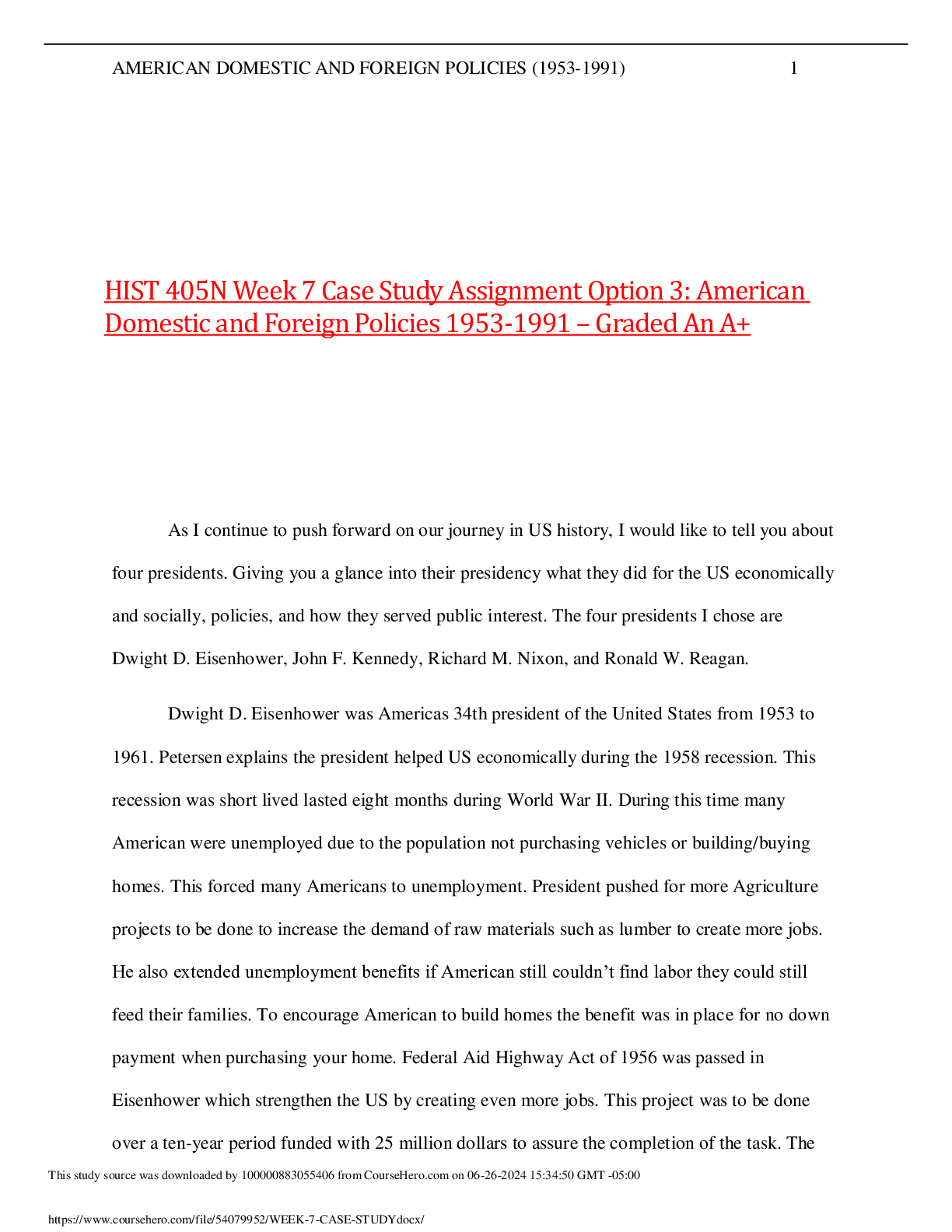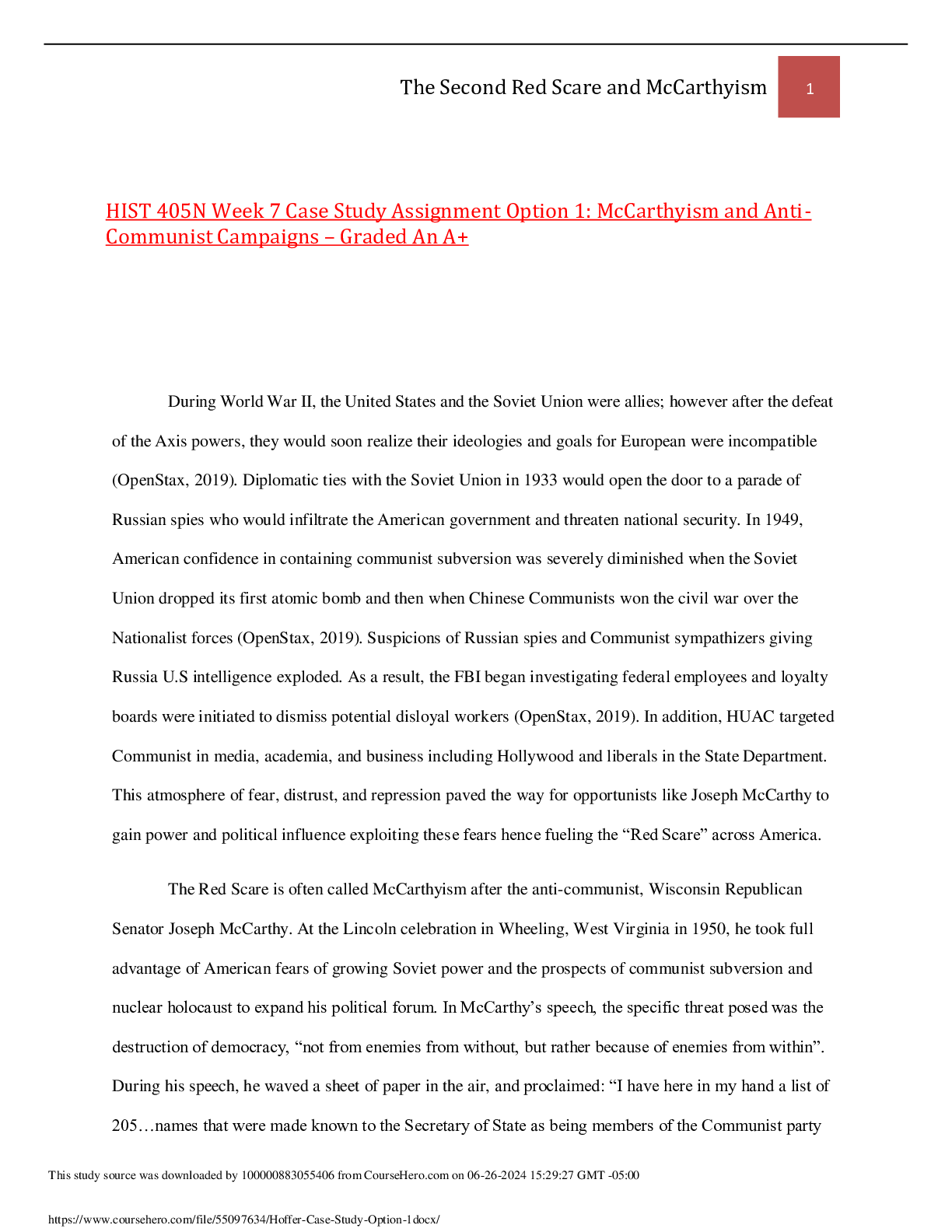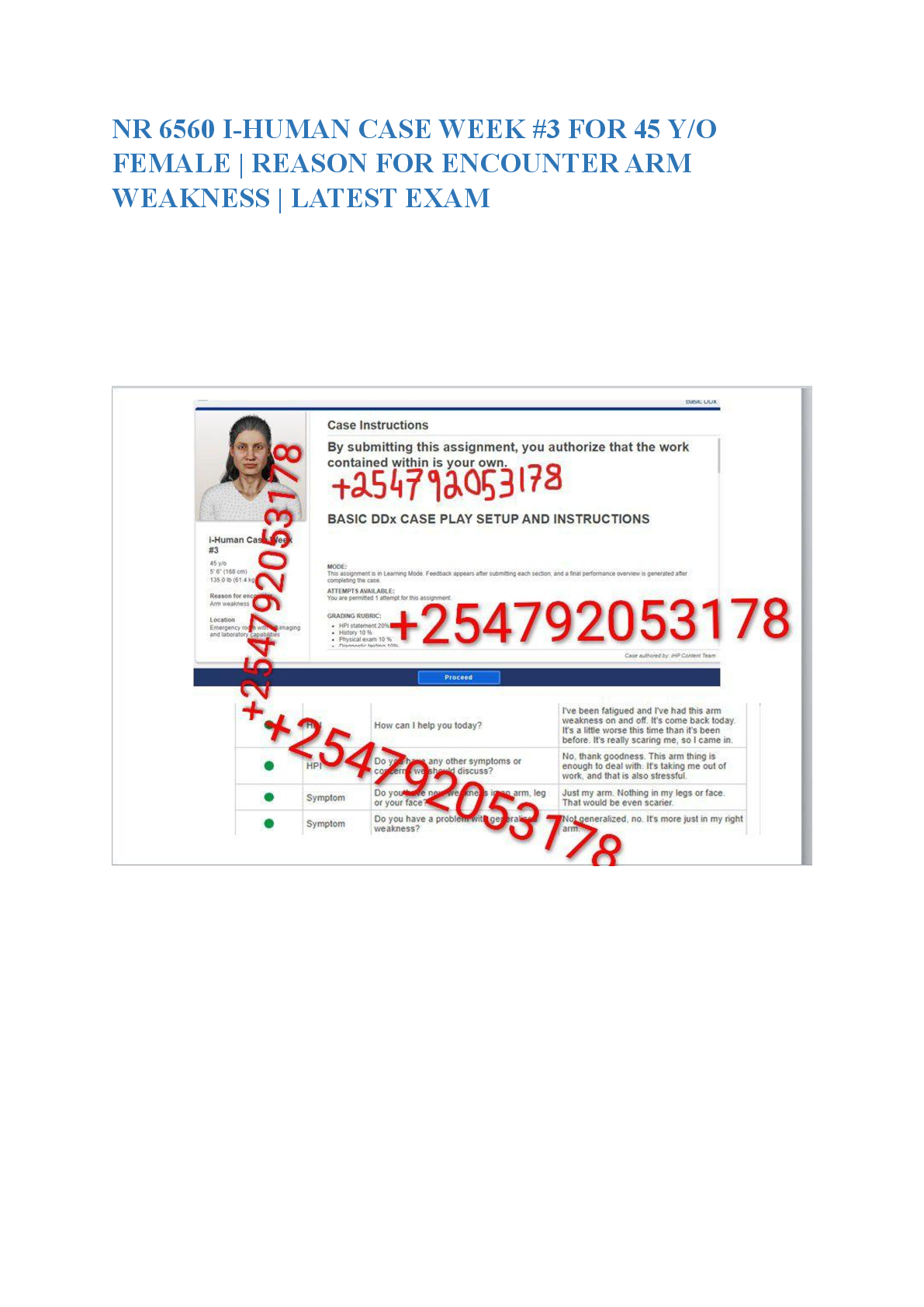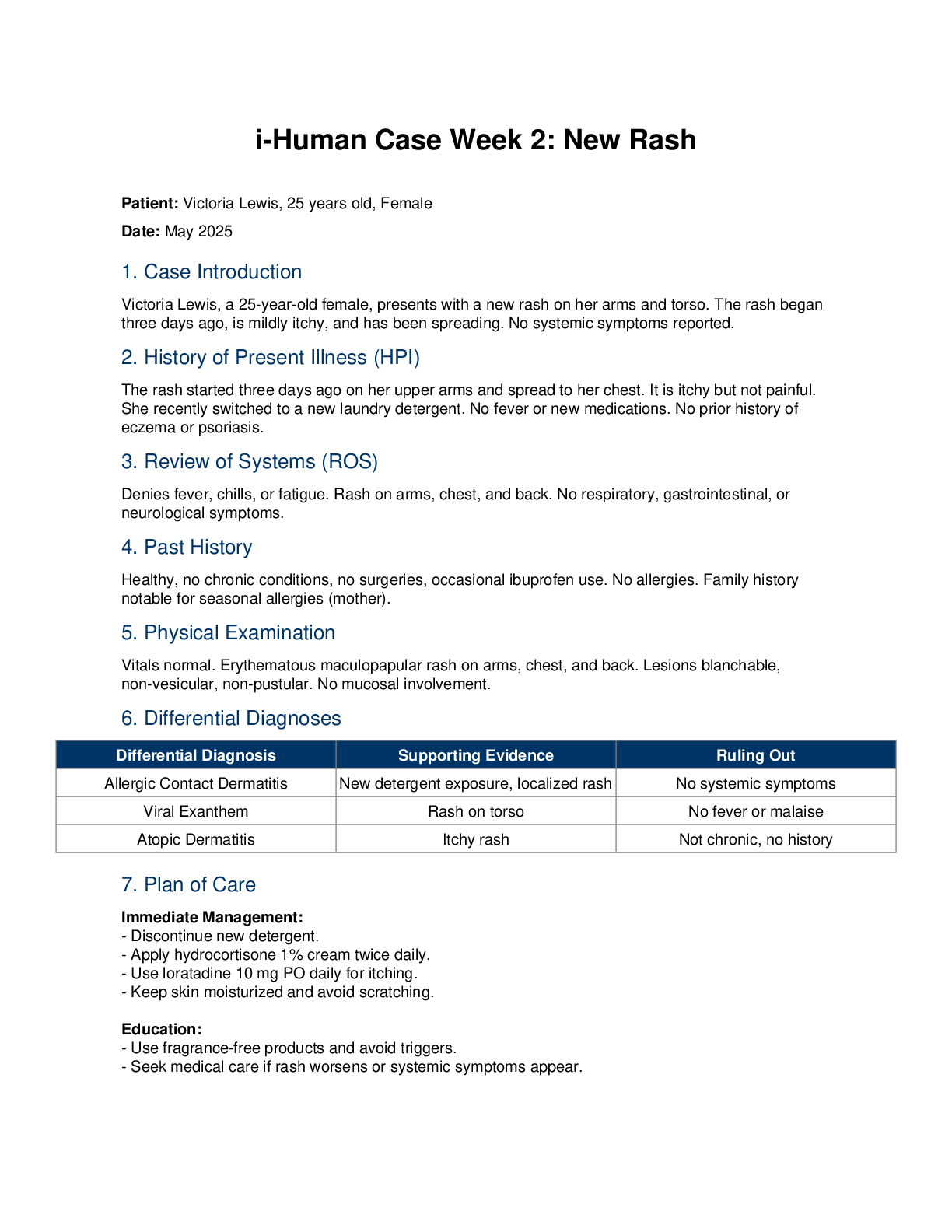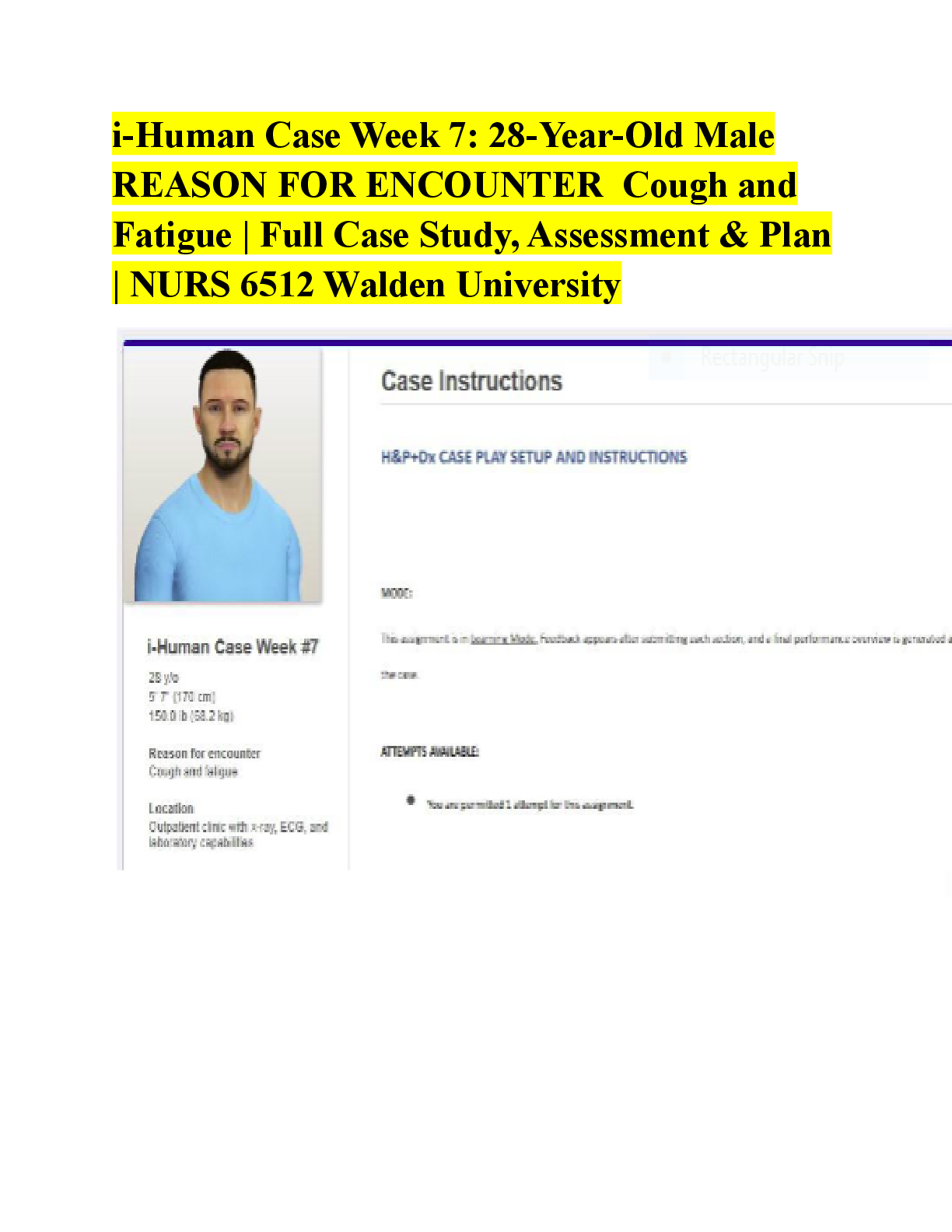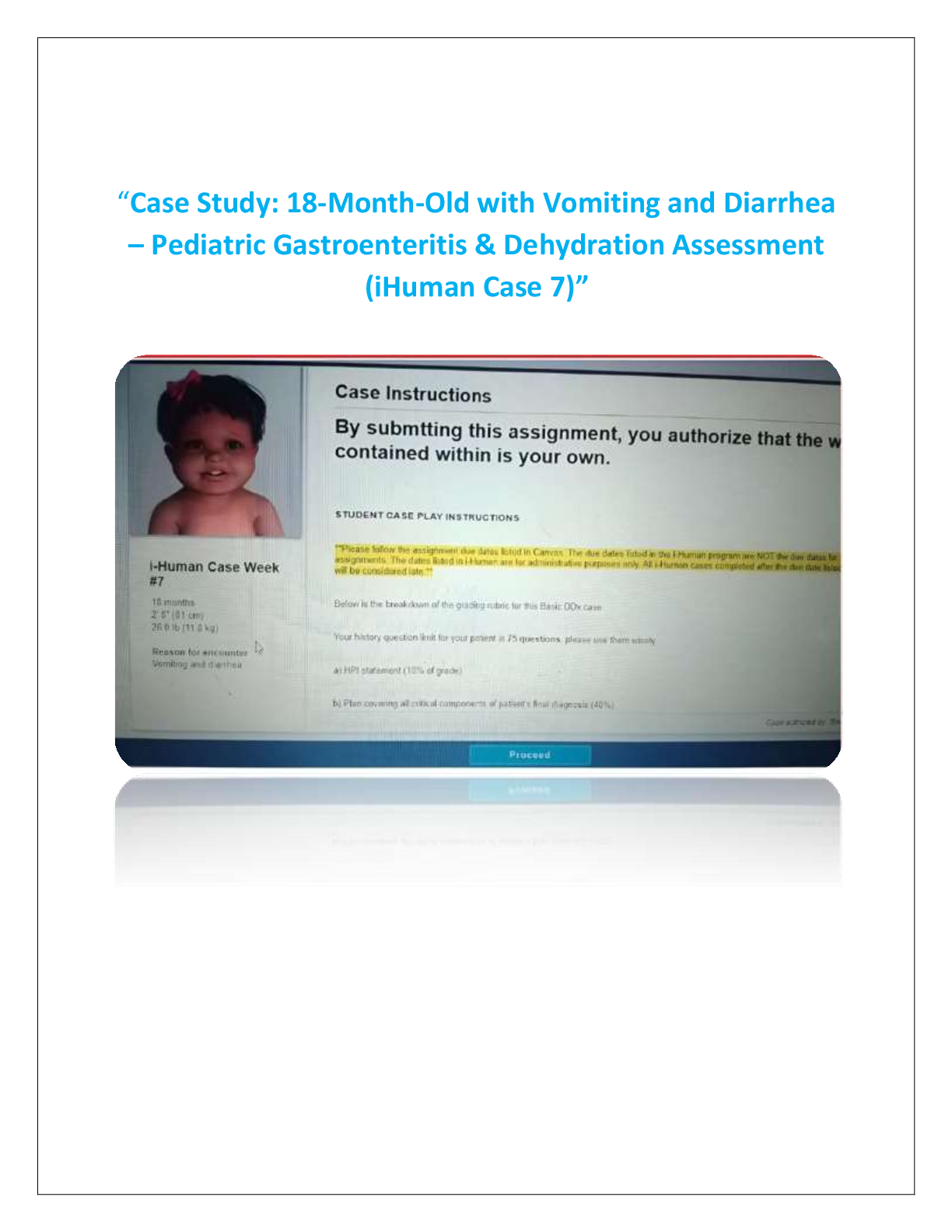AMERICAN HISTORY > CASE STUDY > HIST-405N Week 7 Case Study Assignment Option 2: The Civil Rights Movement: Option 2 – Graded An A (All)
HIST-405N Week 7 Case Study Assignment Option 2: The Civil Rights Movement: Option 2 – Graded An A+
Document Content and Description Below
HIST-405N Week 7 Case Study Assignment Option 2: The Civil Rights Movement: Option 2 – Graded An A+ The Civil Rights Movement emerged as an umbrella term signifying the struggle for social ... justice and equality. This struggle focused on helping African Americans gain equal rights, especially after the American Civil War ended slavery (Carson, 2020). Even with the abolition of slavery, African Americans still struggled to achieve equality; they continued to endure discrimination. African Americans suffered distressing impacts of racism, particularly in the South (Corbett et al., 2014). Accordingly, various activists emerged campaigning for the rights of the minority. Dr. Martin Luther King, Jr. is one of the most eminent civil rights activists that also left an unforgettable mark in American history. King advocated non-violent protests and civil disobedience; his peaceful messages enticed thousands of supporters who rallied behind the call to end segregation and discrimination against the Negros. He advocated for equal rights for the blacks through protest rallies, sit-ins, marches, and boycotts (Austin, 2002). One of his most historic events was the March on Washington that occurred on August 28, 1963, ending in King’s famous speech, ‘I Have a Dream’ that became a slogan for equality and freedom. The March on Washington pressured President J. F. Kennedy to fulfill his promise of civil rights (Corbett et al., 2014). The protestors held demonstrations in the quest for jobs and freedom. Thus, Martin Luther King Jr. and other civil rights activists of the 1960s were highly influential and left an indelible mark in America and beyond. The Civil Rights Movement of the 1960s had remarkable impacts on the nation. During the March on Washington event, King and other activists assembled over 250,000 people from different races, marching through Washington in protest against racial segregation and other forms of racial injustice (History, Art & Archives, U.S. House of Representatives, 2008). According to Austin (2002), the movement yielded positive changes that are still evident today. Their efforts delivered the Civil Rights Act of 1964 and the Voting Rights Act of 1965; these federal laws banned segregation, guaranteeing African Americans equal protection and safeguarding their voting rights (Corbett et al., 2014). King and other civil rights activists witnessed the signing of these acts into law. The two laws resulting from the Civil Rights Movements were quite impactful on the American nation. The 1964 Civil Rights Act guaranteed equal employment opportunities for all and advocated the integration of public facilities. Notably, the Voting Rights Act furthered the Civil Rights law; it outlawed the use of voter literacy tests, giving African Americans the right to vote (Corbett et al., 2014). This law also permitted the attorney general to contest state and local poll taxes, rendering them unconstitutional in 1966. Even after the assassination of the civil rights leader, more laws emerged in fulfillment of King’s dream. Days after King’s assassination, the Fair Housing Act became law, preventing housing discrimination based on race, religion, national origin, and sex (History, Art & Archives, U.S. House of Representatives, 2008). This law was the last legislation enacted during the civil rights era. The Fair Housing Act was a fulfillment of King’s dream that envisioned an American society that is void of segregation. Therefore, the Civil Rights Movements of the 1960s generated three vital legislations that ended discriminatory employment, housing practices, and black voter suppression. The Civil Rights Act of 1964 had significant impacts on minority groups across the continent. First, it ended segregation in public places and outlawed discrimination based on race, religion, ethnicity, national origin, or sex (History, Art & Archives, U.S. House of Representatives, 2008). This law increased social and economic mobility for the blacks across the nation, providing women, religious minorities, low-income families, and African Americans greater access to resources. Moreover, the Act improved equity in education. Its enactment led to greater educational opportunities for women, immigrants, and people with disabilities, and LGBTQ persons. The Civil Rights Act influenced various educational policies that emphasize equality. For instance, the Elementary and Secondary Education Act (ESEA) of 1965 increased access to educational opportunities for African Americans and persons with disabilities (U.S. Department of Education, 1999). Many schools across the continent started recognizing and supporting students regardless of their race, abilities, sex, or religion. Accordingly, the Civil Rights Act compelled learning institutions to improve their admission policies and practices to allow racial, ethnic, and socio-economic diversity and integration. The Civil Rights Movement of the 1960s thrived on the philosophy of non-violence. Activists of the time, including Martin Luther King Jr., employed the principle of passive resistance and nonviolence as a tool to dismantle institutionalized racial discrimination and inequality. These strategies are still relevant today. The contemporary civil rights activists still employ similar tactics to address ethnic inequalities. For example, the recently launched “Black Lives Matter” campaign adopted the tactics of the1960s civil rights activism. This contemporary movement thrives on similar ideologies to those of the Civil Rights Movement of the 1960s. The response to modern civil rights activism is also similar to that of the 1960s. Both movements involve thousands of people marching on the streets in protests against repressive policies (Bhambra, 2015). Although they both begin as non-violent protests, they culminate in violence due to brutal police reaction. During Dr. King’s time, non-violent disobedience culminated in violence that led to assassinations. This history is repeating itself, as contemporary civil activists’ resort to non-violent protests and civil disobedience to bring about the desired change in the present times. The Civil Rights Movement of the 1960s would significantly influence diversity in contemporary American society. If such movements came back today, as witnessed recently with the Black Lives Matter movement, they would enhance diversity the same way they did back then. Such movements would bring together people from diverse racial, religious, and socio- political backgrounds to fight injustices and advocate for equality. The movements today use protests, social media, and publicity to advance their course. The same way Dr. King’s passionate speech wooed thousands of people opposed to racial segregation, contemporary civil rights activists have strong solidarity that transcends bloody racial divides. For example, George Floyd’s death sparked a global movement, in which anti- police protestors utilized non-violent protests to advocate reforms. The world has witnessed dramatic protests similar to the March on Washington of 1963. The protests seek to resolve long- standing racial injustices. Although contemporary movements lack a single voice demanding change, they both call for social change and racial equality through non-violent protests (Bhambra, 2015). The contemporary civil rights movement is a collective force of social activists and organizers opposing police violence, widespread injustice, and disenfranchisement. Such movements influence society significantly. The quest for racial equality has a deep historical root. During Dr. Martin Luther King’s time, leaders employed non-violent protests, sit-ins, marches, and boycotts to advocate for change. The hallmark of their effort was the March on Washington in 1963 that culminated in King’s passionate and persuasive speech that captivated the crowds, pushing them to fight for equality and freedom. During this march, activists from different racial, ethnic, and socio- economic backgrounds joined forces to advocate against racial segregation. Their efforts bore fruits, as various legislations emerged to abolish racial discrimination in employment and allow blacks to have voting rights. Such tactics of the 1960s are still relevant. Notably, the contemporary civil rights activists also employ non-violent protests, social media campaigns, and publicity to advance their course. For example, the Black Lives Matter movement is a reflection of the Civil Rights Movements of the 1960s. It seeks to end police brutality against the blacks and other forms of racial injustices. Thus, the Civil Rights Movement of 1960 left a lasting mark that still thrives for transformation in society to date. References Austin, C. J. (2002, February). On violence and nonviolence: The Civil Rights Movement in Mississippi. Retrieved from Hitory Now: http://www.mshistorynow.mdah.ms.gov/articles/62/the-civil-rights-movement-in- mississippi-on-violence-and-nonviolence Bhambra, G. K. (2015, January 3). Civil rights for the twenty-first century: Lessons from U.S. history. Retrieved from Discover Society: https://discoversociety.org/2015/01/03/civil- rights-for-the-twenty-first-century-lessons-from-u-s-history/ Carson, C. (2020, September 17). American civil rights movement. Retrieved from Encyclopædia Britannica: https://www.britannica.com/event/American-civil-rights-movement Corbett, S. P., Janssen, V., Lund, J. M., Pfannestiel, T., Waskiewicz, S., & Vickery, P. (2014). U.S. History. Houston: OpenStax. History, Art & Archives, U.S. House of Representatives. (2008). The Civil Rights Movement And The Second Reconstruction, 1945—1968. Washington, D.C: U.S. Government Printing Office. Retrieved from https://history.house.gov/Exhibitions-and- Publications/BAIC/Historical-Essays/Keeping-the-Faith/Civil-Rights-Movement/ LogistiKHD. (2013). Martin Luther King | "I Have A Dream" Speech. Retrieved from https://www.youtube.com/watch?v=I47Y6VHc3Ms U.S. Department of Education. (1999). Impact of the civil rights laws. Office for Civil Rights. Retrieved from https://www2.ed.gov/about/offices/list/ocr/docs/impact.html [Show More]
Last updated: 1 year ago
Preview 3 out of 7 pages

Loading document previews ...
Buy this document to get the full access instantly
Instant Download Access after purchase
Buy NowInstant download
We Accept:

Reviews( 0 )
$12.00
Can't find what you want? Try our AI powered Search
Document information
Connected school, study & course
About the document
Uploaded On
Jun 26, 2024
Number of pages
7
Written in
All
Additional information
This document has been written for:
Uploaded
Jun 26, 2024
Downloads
0
Views
72




